Table of contents
Gaming keyboards are one of the most important accessories for any PC gamer. They can make or break your gaming experience, whether you’re playing FPS, MOBA, RPG, or any other genre. But how do you choose the best gaming keyboard for your needs and budget?
Buying a keyboard is not as simple and easy as one might think. There are many factors to consider, such as size, layout, switches, features, design, and price. You don’t want to spend a fortune on a branded keyboard that doesn’t suit your preferences, or settle for a cheap and unbranded keyboard that has a short lifespan and poor performance.
In this guide, we will help you find the best gaming keyboard for 2024, based on our extensive research and testing. We will cover the different types of keyboards, the pros and cons of each, and the top 7 gaming keyboards that we recommend for various categories. Whether you’re looking for a full-size, TKL, mini, wireless, RGB, or ergonomic keyboard, we have you covered.
Types of Keyboards
Before we dive into the specific models, let’s first understand the different types of keyboards that are available in the market. The main types are:
- Mechanical keyboards: These keyboards use individual mechanical switches under each key, which provide a tactile and audible feedback when pressed. Mechanical keyboards are generally more durable, responsive, and customizable than other types of keyboards, but they are also more expensive and louder. Mechanical keyboards are preferred by many gamers and typists, as they offer a satisfying and precise typing experience. There are various types of mechanical switches, such as Cherry MX, Razer, Logitech, SteelSeries, and more, each with different characteristics and feel. Some of the most common switch types are:
- Linear switches: These switches have a smooth and consistent keystroke, without any bump or click. They are ideal for fast and smooth gaming, as they require less force and have a shorter travel distance. However, they may not be very suitable for typing, as they lack tactile feedback and may cause accidental presses. Some examples of linear switches are Cherry MX Red, Black, and Speed, and Razer Yellow.
- Tactile switches: These switches have a noticeable bump at the actuation point, which provides a tactile feedback when pressed. They are good for both gaming and typing, as they offer a balance between speed and accuracy. However, they may not be as smooth or quiet as linear switches. Some examples of tactile switches are Cherry MX Brown, Clear, and Blue, and Razer Orange.
- Clicky switches: These switches have both a bump and a click at the actuation point, which provide both tactile and audible feedback when pressed. They are great for typing, as they offer a satisfying and crisp typing experience. However, they may not be very suitable for gaming, as they are louder and slower than linear and tactile switches. Some examples of clicky switches are Cherry MX Blue, Green, and White, and Razer Green.
- Membrane keyboards: These keyboards use a rubber or silicone dome under each key, which collapses when pressed and registers the keystroke. Membrane keyboards are generally cheaper, quieter, and more resistant to dust and spills than mechanical keyboards, but they are also less durable, responsive, and customizable. Membrane keyboards are often found in laptops and low-end keyboards, as they offer a decent and affordable typing experience. However, they may not be very satisfying or accurate for gaming, as they have a mushy and inconsistent feel, and may suffer from ghosting and rollover issues.
- Hybrid keyboards: These keyboards use a combination of mechanical and membrane technologies, such as scissor switches, optical switches, or hall effect switches. Hybrid keyboards aim to offer the best of both worlds, by providing a smooth, fast, and quiet typing experience, while also being durable, responsive, and customizable. Hybrid keyboards are relatively new and innovative, and may offer some unique features and advantages over traditional keyboards. However, they may also be more expensive and harder to find than mechanical and membrane keyboards.
Factors to Consider
Now that you know the different types of keyboards, let’s look at some of the factors that you should consider when choosing a gaming keyboard. These factors are:
- Size: Keyboards come in various sizes, depending on the number and arrangement of keys. The most common sizes are:
- Full-size keyboards: These keyboards have all the standard keys, including the alphanumeric keys, the function keys, the arrow keys, and the number pad. Full-size keyboards are the most versatile and comfortable, as they offer all the functionality and convenience that you may need. However, they are also the largest and heaviest, and may take up a lot of desk space and limit your mouse movement. Full-size keyboards are suitable for gamers who need a lot of keys, such as MMO, RTS, or RPG players, or who also use their keyboards for work or productivity.
- Tenkeyless (TKL) keyboards: These keyboards have all the standard keys, except the number pad. TKL keyboards are the most popular and balanced, as they offer most of the functionality and comfort of full-size keyboards, while also being more compact and lightweight. They also free up some desk space and allow you to position your mouse closer to your keyboard, which may improve your ergonomics and posture. TKL keyboards are suitable for gamers who don’t need a lot of keys, such as FPS, MOBA, or platformer players, or who prefer a minimalist and sleek design.
- Mini keyboards: These keyboards have fewer keys than TKL keyboards, usually by omitting some of the function keys, the arrow keys, or both. Mini keyboards are the smallest and lightest, and take up the least desk space. They are ideal for gamers who value portability, mobility, and aesthetics, or who have limited space or travel frequently. However, they may also sacrifice some functionality and comfort, as they may require you to use additional keys or software to access some features or commands. Mini keyboards are suitable for gamers who only need the essential keys, such as FPS, MOBA, or platformer players, or who are comfortable with using layers and macros.
- Layout: Keyboards have different layouts, depending on the region, language, and preference. The most common layouts are:
- ANSI layout: This is the standard layout for the US and most of the world. It has 104 keys on a full-size keyboard, with a horizontal Enter key and a backslash key above it. It also has a large left Shift key and a small right Shift key.
- ISO layout: This is the standard layout for the UK and some parts of Europe. It has 105 keys on a full-size keyboard, with a vertical Enter key and a backslash key next to it. It also has a small left Shift key and a large right Shift key.
- JIS layout: This is the standard layout for Japan. It has 109 keys on a full-size keyboard, with a horizontal Enter key and a backslash key above it. It also has a small left Shift key and a large right Shift key. It also has an extra row of keys on the right side, which are used for Japanese characters and symbols.
The layout of your keyboard may affect your typing speed, accuracy, and comfort, especially if you are used to a different layout. You should choose a layout that matches your region, language, and preference, or that you can easily adapt to.
- Switches: As we mentioned earlier, switches are the mechanisms under each key that register the keystroke. Switches are one of the most important factors to consider, as they determine the feel, sound, and performance of your keyboard. Switches have different characteristics, such as:
- Actuation force: This is the amount of force required to press a key and register a keystroke. It is measured in grams (g) or centinewtons (cN). The actuation force affects how easy or hard it is to type on a keyboard, and may vary depending on the type and brand of the switch. Generally, lower actuation force means faster and smoother typing, while higher actuation force means more resistance and accuracy. The average actuation force for most switches is around 45-60g, but some switches may go as low as 35g or as high as 80g.
- Actuation point: This is the point at which a key registers a keystroke, usually halfway through the keystroke. It is measured in millimeters (mm). The actuation point affects how responsive and precise a keyboard is, and may vary depending on the type and brand of the switch. Generally, lower actuation point means faster and more sensitive typing, while higher actuation point means more control and accuracy. The average actuation point for most switches is around 2mm, but some switches may go as low as 1.2mm or as high as 3.6mm.
- Travel distance: This is the total distance that a key can travel when pressed, from the top to the bottom. It is measured in millimeters (mm). The travel distance affects how comfortable and satisfying a keyboard is, and may vary depending on the type and brand of the switch. Generally, lower travel distance means faster and smoother typing, while higher travel distance means more feedback and cushioning. The average travel distance for most switches is around 4mm, but some switches may go as low as 3mm or as high as 5mm.
You should choose switches that match your typing style, preference, and use case. For gaming, you may want switches that are fast, smooth, and responsive, such as linear or tactile switches with low act
Best gaming keyboards for 2024
Steelseries Apex Pro
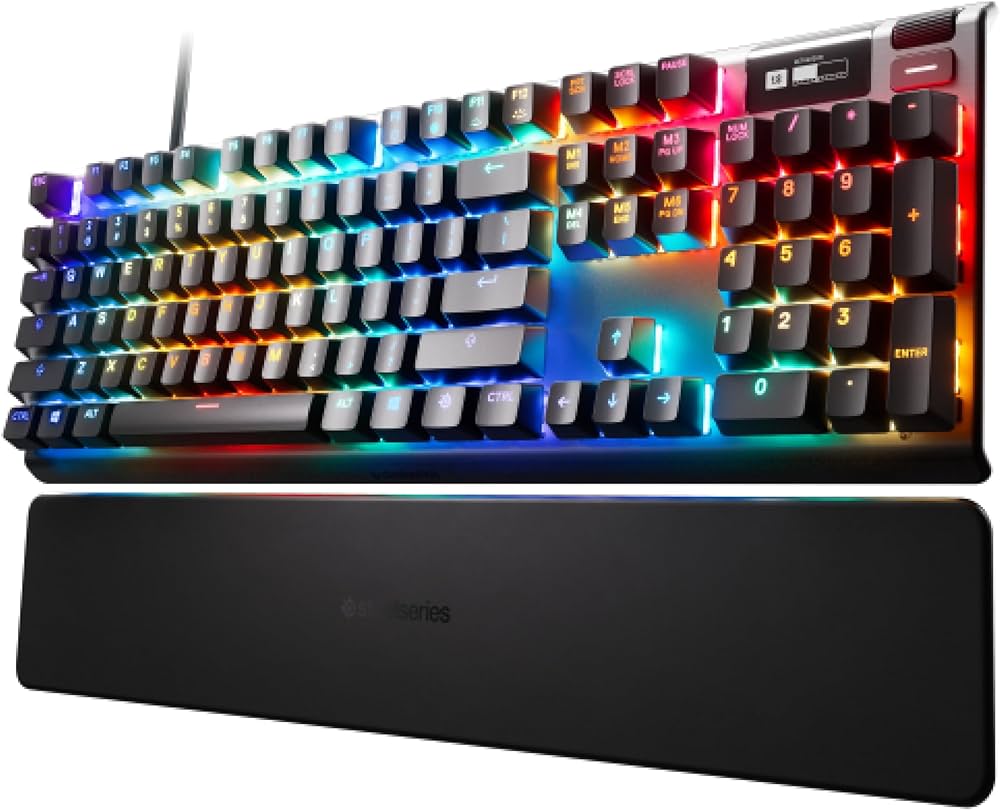
This is the best overall gaming keyboard, according to PC Gamer. It has a full-size layout, a sleek aluminum frame, and customizable OLED display. It also features adjustable mechanical switches that let you change the actuation point from 0.4mm to 3.6mm, depending on your preference. The Apex Pro has per-key RGB lighting, dedicated media keys, and a magnetic wrist rest. It costs around $200.
Razer BlackWidow V4 Pro
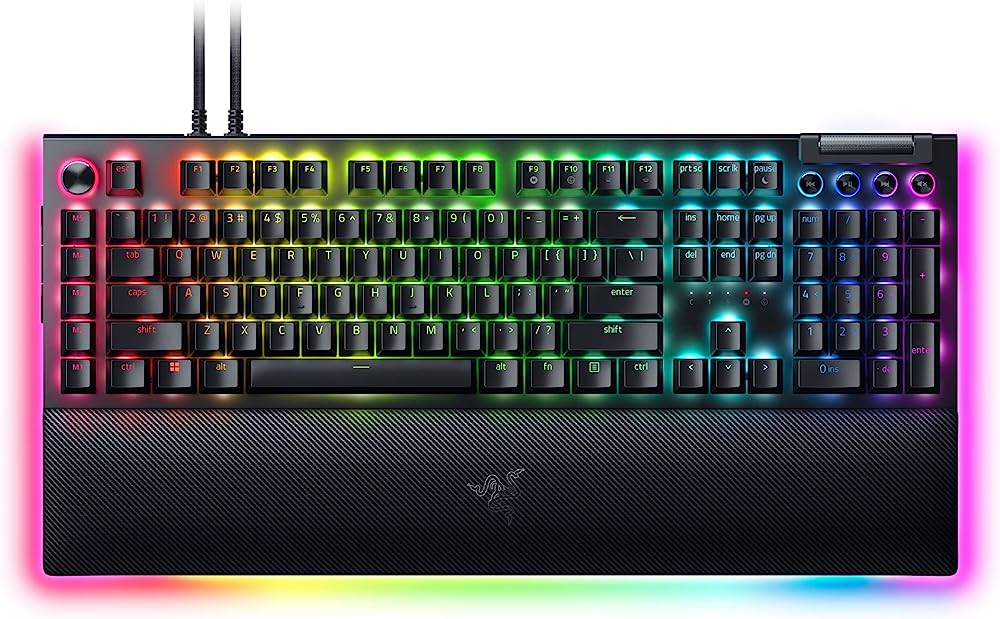
This is the best splurge gaming keyboard, according to Tom’s Hardware. It has a full-size layout, a durable metal top plate, and a plush leatherette wrist rest. It also features Razer’s own mechanical switches, which are fast, smooth, and quiet. The BlackWidow V4 Pro has RGB backlighting and underglow, media keys, macro keys, and wireless connectivity. It costs around $230.
Aukey KM-G17
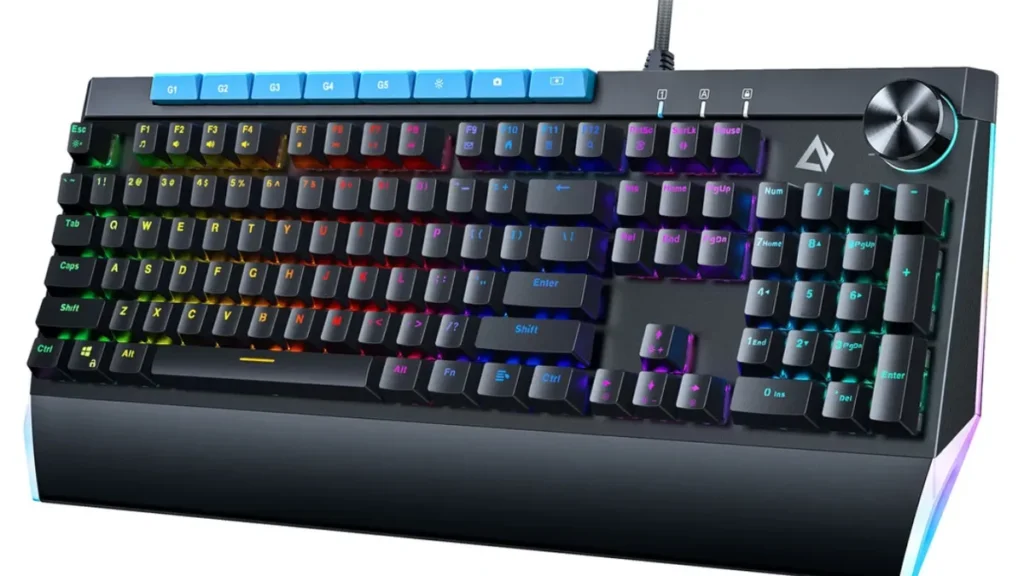
This is the best budget gaming keyboard, according to Tom’s Hardware. It has a full-size layout, a sturdy plastic frame, and a splash-resistant design. It also features Outemu Blue switches, which are clicky and tactile. The KM-G17 has RGB backlighting, dedicated macro keys, and anti-ghosting technology. It costs around $60.
Roccat Vulcan II Max
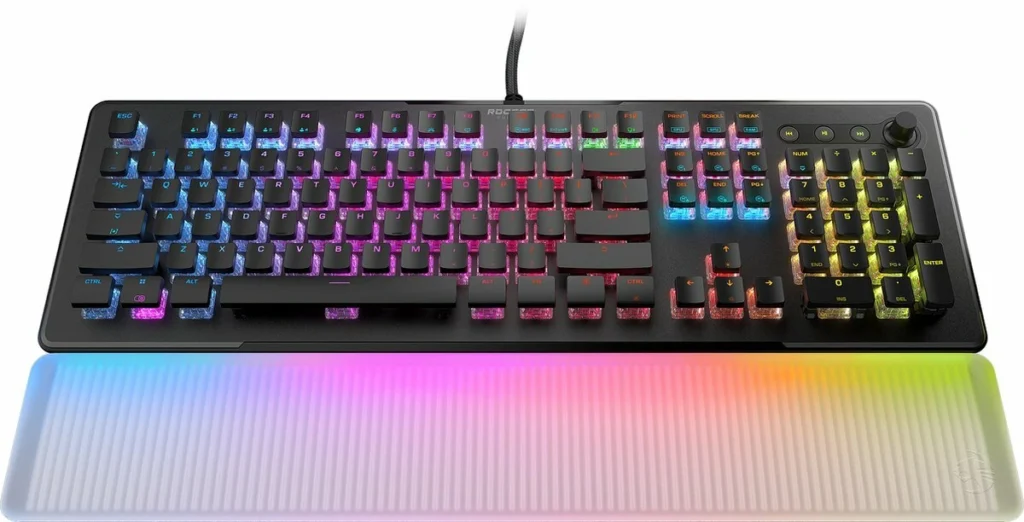
This is the best looking gaming keyboard, according to Tom’s Hardware. It has a full-size layout, a slim and elegant design, and a translucent wrist rest. It also features Roccat’s own Titan switches, which are linear and responsive. The Vulcan II Max has bright per-key RGB lighting, underglow, and media keys. It costs around $180.
Asus ROG Strix Scope II 96 Wireless
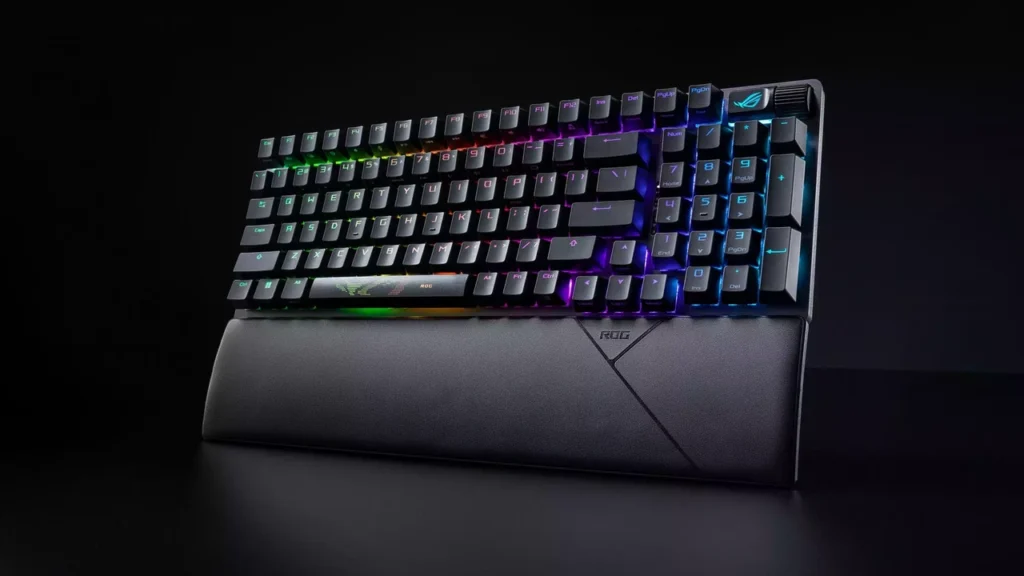
This is the best wireless gaming keyboard, according to PC Gamer. It has a 96-percent layout, which keeps the number pad but is not much larger than a TKL. It also features hot-swappable switches, which let you change the feel and sound of your keyboard. The Strix Scope II 96 Wireless has RGB lighting, media keys, and an impressive 1,500+ hours of battery life. It costs around $150.
SteelSeries Apex Pro TKL Wireless
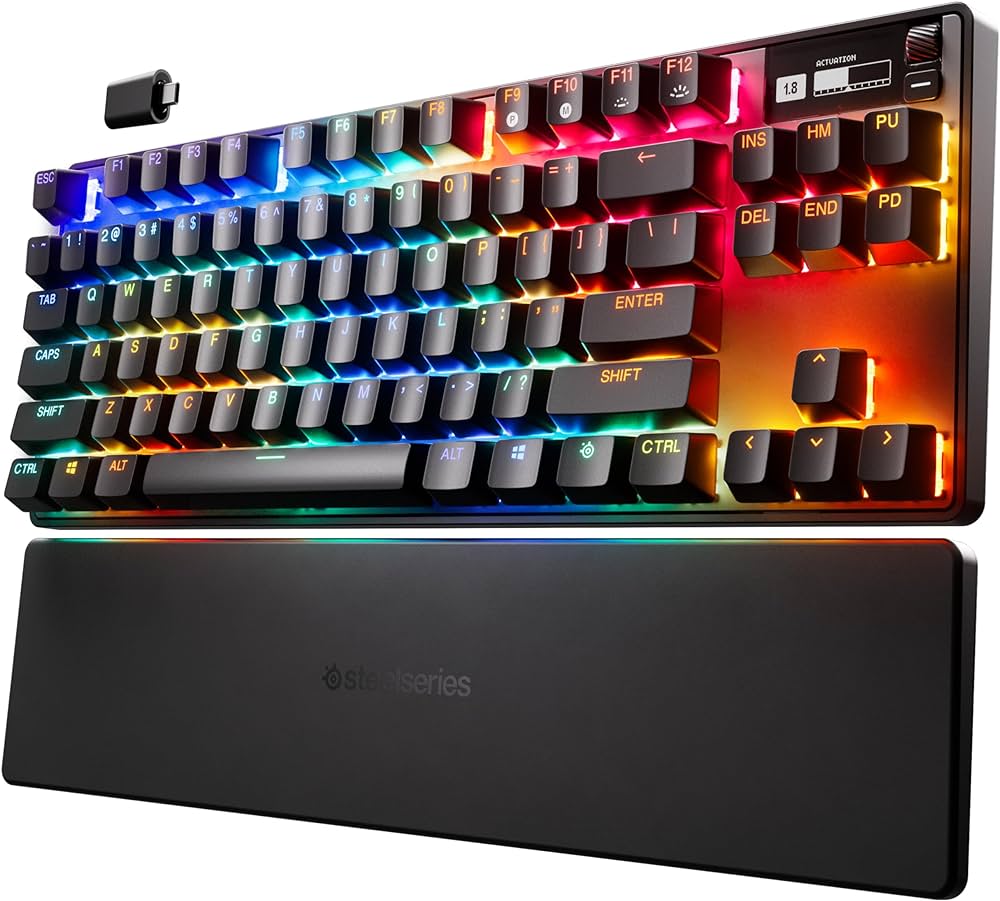
This is the best TKL gaming keyboard, according to PC Gamer. It has a TKL layout, which saves desk space and improves ergonomics. It also features the same adjustable mechanical switches as the Apex Pro, which let you customize the actuation point. The Apex Pro TKL Wireless has per-key RGB lighting, an OLED display, and wireless connectivity. It costs around $180.
Epomaker RT100
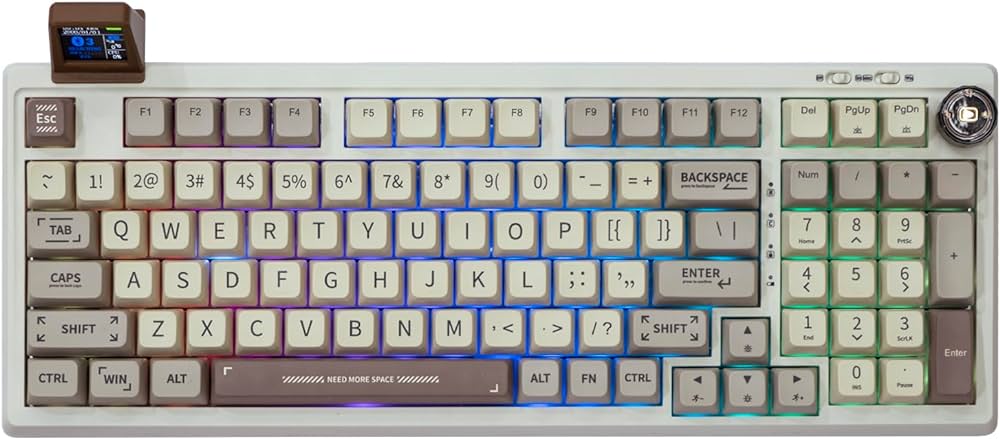
This is the best retro gaming keyboard, according to Video Gamer. It has a 60-percent layout, which is compact and portable. It also features round keycaps, which give it a vintage look and feel. The RT100 has RGB backlighting, Bluetooth connectivity, and multiple switch options. It costs around $80.